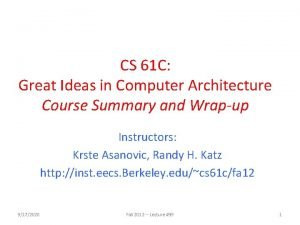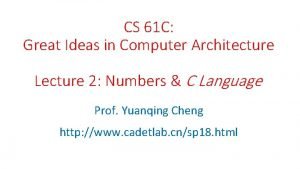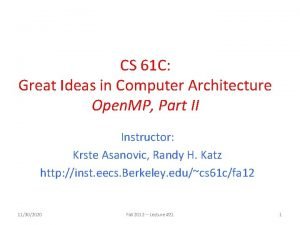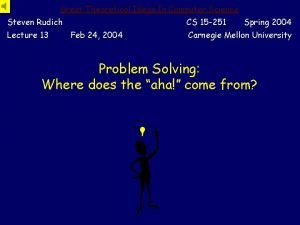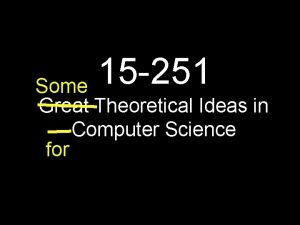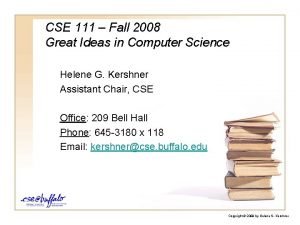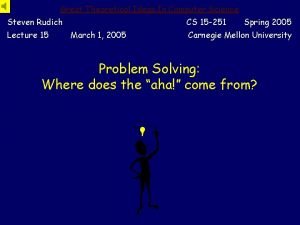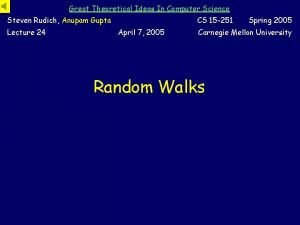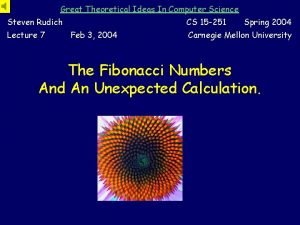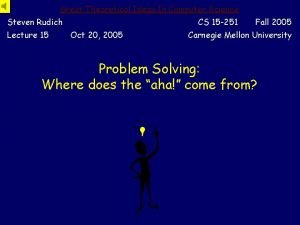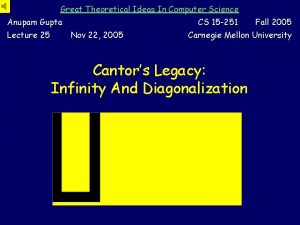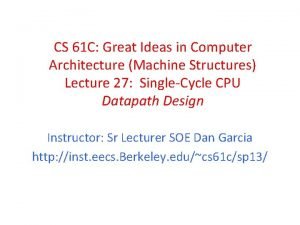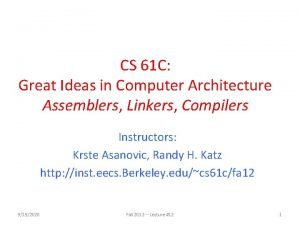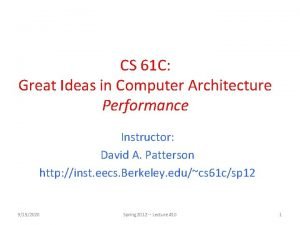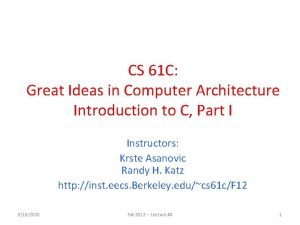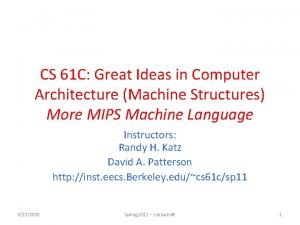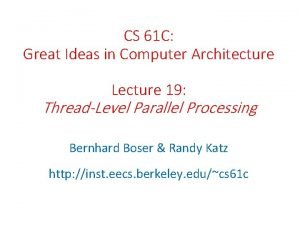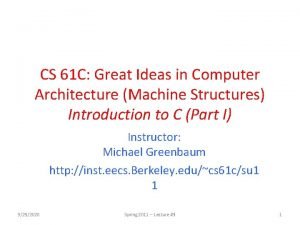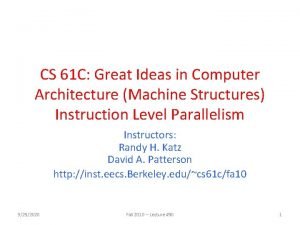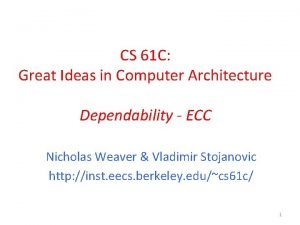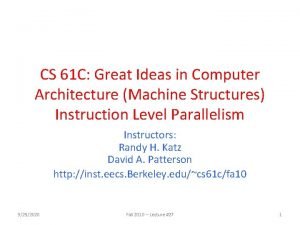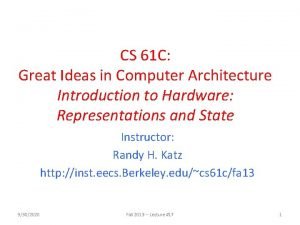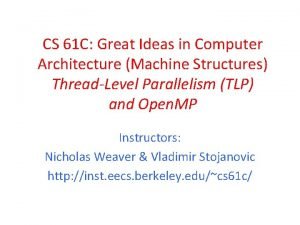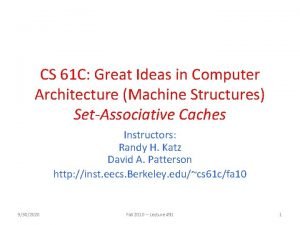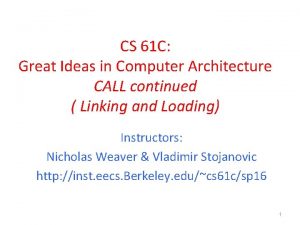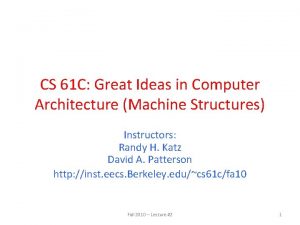CS 61 C Great Ideas in Computer Architecture

















































- Slides: 49

CS 61 C: Great Ideas in Computer Architecture (Machine Structures) Switches, Transistors, Gates, Flip-Flops Instructor: Michael Greenbaum 10/2/2020 Summer 2011 -- Lecture 18 1

Review • Sequential software is slow software – SIMD and MIMD only path to higher performance • Multiprocessor/Multicore uses Shared Memory – Cache coherency implements shared memory even with multiple copies in multiple caches – False sharing a concern; watch block size! • Data races lead to subtle parallel bugs • Synchronization via atomic operations: – MIPS does it with Load Linked + Store Conditional • Open. MP as simple parallel extension to C – Threads, Parallel for, private, critical sections, … 10/2/2020 Summer 2011 -- Lecture 18 2

Levels of Representation/Interpretation High Level Language Program (e. g. , C) Compiler Assembly Language Program (e. g. , MIPS) Assembler Machine Language Program (MIPS) temp = v[k]; v[k] = v[k+1]; v[k+1] = temp; lw lw sw sw 0000 1010 1100 0101 $t 0, 0($2) $t 1, 4($2) $t 1, 0($2) $t 0, 4($2) 1001 1111 0110 1000 1100 0101 1010 0000 Anything can be represented as a number, i. e. , data or instructions 0110 1000 1111 1001 1010 0000 0101 1100 1111 1000 0110 0101 1100 0000 1010 1000 0110 1001 1111 Machine Interpretation Hardware Architecture Description (e. g. , block diagrams) Architecture Implementation Logic Circuit Description (Circuit Schematic Diagrams)Summer 2011 -- Lecture 18 10/2/2020 3

Agenda • • Switching Networks, Transistors Administrivia Combinational Logic Break Combinational Logic (cont'd) State Elements Summary 10/2/2020 Fall 2010 -- Lecture #22 4

Hardware Design • Next several weeks: we’ll study how a modern processor is built; starting with basic elements as building blocks • Why study hardware design? – Understand capabilities and limitations of hw in general and processors in particular – What processors can do fast and what they can’t do fast (avoid slow things if you want your code to run fast!) – Background for more in depth hw courses (CS 150, CS 152) – There is just so much you can do with standard processors: you may need to design own custom hw for extra performance – Even some commercial processors today have customizable hardware! 10/2/2020 Summer 2011 -- Lecture 18 5

Synchronous Digital Systems Hardware of a processor, such as the MIPS, is an example of a Synchronous Digital System Synchronous: • All operations coordinated by a central clock § “Heartbeat” of the system! Digital: • Represent All values by 2 discrete values • Electrical signals are treated as 1’s and 0’s • 1 and 0 are complements of each other • High /low voltage for true / false, 1 / 0 10/2/2020 Summer 2011 -- Lecture 18 6

Switches: Basic Element of Physical Implementations • Implementing a simple circuit (arrow shows action if wire changes to “ 1” or is asserted): A Z Close switch (if A is “ 1” or asserted) and turn on light bulb (Z) A Z Open switch (if A is “ 0” or unasserted) and turn off light bulb (Z) Z A 10/2/2020 Summer 2011 -- Lecture 18 7

Switches (cont’d) • Compose switches into more complex ones (Boolean functions): AND B A Z A and B A OR Z A or B B 10/2/2020 Summer 2011 -- Lecture 18 8

Historical Note • Early computer designers built ad hoc circuits from switches • Began to notice common patterns in their work: ANDs, ORs, … • Master’s thesis (by Claude Shannon) made link between work and 19 th Century Mathematician George Boole – Called it “Boolean” in his honor • Could apply math to give theory to hardware design, minimization, … 10/2/2020 Summer 2011 -- Lecture 18 9

Transistor Networks • Modern digital systems designed in CMOS – MOS: Metal-Oxide on Semiconductor – C for complementary: use pairs of normally-open and normally-closed switches • CMOS transistors act as voltage-controlled switches – Similar, though easier to work with, than relay switches from earlier era 10/2/2020 Summer 2011 -- Lecture 18 10

CMOS Transistors Gate Drain Source • Three terminals: source, gate, and drain – Switch action: if voltage on gate terminal is (some amount) higher/lower than source terminal then conducting path established between drain and source terminals (switch is closed) Gate Source Gate Drain Source Note circle symbol to indicate “NOT” or “complement” Drain n-channel transitor p-channel transistor open when voltage at Gate is low closes when: voltage(Gate) > voltage (Threshold) closed when voltage at Gate is low opens when: voltage(Gate) > voltage (Threshold) 10/2/2020 Summer 2011 -- Lecture 18 11

What’s wrong with this? B A Z = A and B 1 A 1 B Z = A or B The output Z can be left “floating, ” attached to nothing! The properties of a “floating” wire are very unstable. 10/2/2020 Summer 2011 -- Lecture 18 12

CMOS circuit rules • Never leave a wire undriven (“floating”) – Make sure there’s always a path to Vdd or gnd (ground) • Never create a path from Vdd to gnd (short circuit!) • Don’t pass weak values – – N-type transistors pass weak 1’s (Vdd - Vth) N-type transistors pass strong 0’s (gnd) Use N-type transistors only to pass 0’s (n to negative) Conversely for P-type transistors • Pass weak 0’s (Vth), strong 1’s (Vdd) • Use P-type transistors only to pass 1’s (p to positive) – Use pairs of N-type and P-type to get strong values From University of Texas at Austin CS 310 - Computer Organization Spring 2009 Don Fussell

MOS Networks p-channel transistor closed when voltage at Gate is low opens when: voltage(Gate) > voltage (Threshold) X 3 v what is the relationship between x and z? x Y 0 v n-channel transitor 0 volts (gnd) 3 volts (Vdd) z 3 volts (Vdd) 0 volts (gnd) open when voltage at Gate is low closes when: voltage(Gate) > voltage (Threshold) Called an invertor or not gate 10/2/2020 Summer 2011 -- Lecture 18 14

Agenda • • Switching Networks, Transistors Administrivia Combinational Logic Break Combinational Logic (cont'd) State Elements Summary 10/2/2020 Fall 2010 -- Lecture #22 15

Administrivia • Midterm rubric is posted • Project #2: Matrix Multiply Performance Improvement – Work in groups of two! – Part 1: Due July 24 (this Sunday) – Part 2: Due July 31 • HW #3 also due July 27 10/2/2020 Spring 2011 -- Lecture #15 16

Agenda • • Switching Networks, Transistors Administrivia Combinational Logic Break Combinational Logic (cont'd) State Elements Summary 10/2/2020 Fall 2010 -- Lecture #22 17

Two Input Networks X what is the relationship between x, y and z? x y z Y 3 v 0 volts Z 0 v x Y y z 0 volts 3 v 0 volts 3 volts Z 0 v 3 volts 0 volts 3 volts X 10/2/2020 0 volts 3 volts Summer 2011 -- Lecture 18 18

Two Input Networks: Peer Instruction X Y 3 v what is the relationship between x, y and z? x y z Called NAND gate (NOT AND) 0 volts 3 volts Z 0 v X x Y Z 0 v 3 volts 0 volts 3 volts 0 volts y 0 volts 3 v 10/2/2020 0 volts 3 volts z A B C D 0 0 3 3 volts 0 3 0 3 volts 3 3 0 0 volts 3 volts Summer 2011 -- Lecture 18 19

Two Input Networks X Y 3 v what is the relationship between x, y and z? x y z Called NAND gate (NOT AND) 0 volts 3 volts Z 0 v X Y Called NOR gate (NOT OR) 3 v Z 0 v 10/2/2020 Summer 2011 -- Lecture 18 0 volts 3 volts 3 volts 0 volts x y z 0 volts 3 volts 0 volts 3 volts 0 volts 20

Type of Circuits • Synchronous Digital Systems consist of two basic types of circuits: • Combinational Logic (CL) circuits – Output is a function of the inputs only, not the history of its execution – E. g. , circuits to add A, B (ALUs) • Sequential Logic (SL) • Circuits that “remember” or store information • aka “State Elements” • E. g. , memories and registers (Registers) 10/2/2020 Summer 2011 -- Lecture 18 21

CL: General Form A B C D F Y 0 If N inputs, how many distinct functions F do we have? Answer: N inputs => 2 N rows in truth table. A function is a mapping of 0’s and 1’s for each row => 2^(2 N) different possible functions! 10/2/2020 Summer 2011 -- Lecture 18 22

CL: Multiple Outputs A B C X F Y Z D For 3 outputs, just three separate functions: X(A, B, C, D), Y(A, B, C, D), Z(A, B, C, D) 10/2/2020 Summer 2011 -- Lecture 18 23

Logic Gates • A few of the functions on 1 and 2 inputs are given names and special symbols when drawn out: 10/2/2020 Summer 2011 -- Lecture 18 24

Logic Gates (1/2)

Logic Gates (2/2)

And vs. Or– A mnemonic AND Gate Symbol A B AN D Definition C

Truth Table Example #1: 3 -input Majority Circuit Y=ABC + ABC This is called Sum of Products form; Just another way to represent the TT as a logical expression Y = B C + A (B C + B C) Y = B C + A (B + C) More simplified forms (fewer gates and wires) We’ll see how to do this in a bit… 10/2/2020 Summer 2011 -- Lecture 18 28

Truth Table Example #2: 2 -bit Adder How Many Rows? A 1 A 0 B 1 B 0 10/2/2020 C 2 + C 1 C 0 Summer 2011 -- Lecture 18 29

Truth Table Example #3: 32 -bit Unsigned Adder How Many Rows? 10/2/2020 Summer 2011 -- Lecture 18 30

Agenda • • Switching Networks, Transistors Administrivia Combinational Logic Break Combinational Logic (cont'd) State Elements Summary 10/2/2020 Fall 2010 -- Lecture #22 31

Boolean Algebra • Use plus for OR – “logical sum” • Use product for AND (a b or implied via ab) – “logical product” • “Hat” to mean complement (NOT) • Thus ab + a + c = a b + a + c = (a AND b) OR a OR (NOT c ) 10/2/2020 Summer 2011 -- Lecture 18 32

Boolean Algebra: Circuit & Algebraic Simplification 10/2/2020 Fall 2010 -- Lecture #23 33

Laws of Boolean Algebra 10/2/2020 Fall 2010 -- Lecture #23 34

Boolean Algebraic Simplification Example 10/2/2020 Fall 2010 -- Lecture #23 35

Different Representations of CL • • Truth Table Boolean Expression Circuit Diagram Can go from any one of these representations to another: – TT => Expression, Sum Of Products – Expression <=> Circuit Diagram, Just read it off – Expression/Diagram => TT, Try all the inputs 10/2/2020 Summer 2011 -- Lecture 18 36

Signals and Timing Diagrams A group of wires when interpreted as a bit field is called a Bus.

Combinational Logic Circuit Delay 2 3 4 5 3 10 0 1 5 13 4 There is always some delay before a Combinational Logic’s output updates to reflect the inputs. 6

Type of Circuits • Synchronous Digital Systems consist of two basic types of circuits: • Combinational Logic (CL) circuits – Output is a function of the inputs only, not the history of its execution – E. g. , circuits to add A, B (ALUs) • Sequential Logic (SL) • Circuits that “remember” or store information • aka “State Elements” • E. g. , memories and registers (Registers) 10/2/2020 Summer 2011 -- Lecture 18 39

Uses for State Elements • Place to store values for some amount of time: – Register files (like $1 -$31 on the MIPS) – Memory (caches, and main memory) • Help control flow of information between combinational logic blocks – State elements are used to hold up the movement of information at the inputs to combinational logic blocks and allow for orderly passage 10/2/2020 Fall 2010 -- Lecture #23 40

Accumulator Example Why do we need to control the flow of information? Xi SUM S Want: S=0; For X 1, X 2, X 3 over time. . . S = S + Xi Assume: • Each X value is applied in succession, one per cycle • The sum since time 1 is present on S 10/2/2020 Fall 2010 -- Lecture #23 41

First Try: Does this work? X Feedback No! Reason #1: How to control the next iteration of the ‘for’ loop? Reason #2: How do we say: ‘S=0’? 10/2/2020 Fall 2010 -- Lecture #23 42

Second Try: How About This? Register is used to hold up the transfer of data to adder Rough timing … 10/2/2020 Time Fall 2010 -- Lecture #23 43

Register Internals • n instances of a “Flip-Flop” • Flip-flop name because the output flips and flops between 0 and 1 • D is “data input”, Q is “data output” • Also called “D-type Flip-Flop” 10/2/2020 Fall 2010 -- Lecture #23 44

Flip-Flop Timing Behavior (1/2) • Edge-triggered d-type flip-flop – This one is “positive edge-triggered” • “On the rising edge of the clock, input d is sampled and transferred to the output. At other times, the input d is ignored and the previously sampled value is retained. ” • Example waveforms: 10/2/2020 Fall 2010 -- Lecture #23 45

Camera Analogy • Want to take a portrait – timing right before and after taking picture • Set up time – don’t move since about to take picture (open camera shutter) • Hold time – need to hold still after shutter opens until camera shutter closes • Time to data – time from open shutter until can see image on output (viewfinder) 10/2/2020 Summer 2011 -- Lecture 18 46

Flip-Flop Timing Behavior (2/2) • Edge-triggered d-type flip-flop – This one is “positive edge-triggered” • “On the rising edge of the clock, input d is sampled and transferred to the output. At other times, the input d is ignored and the previously sampled value is retained. ” 10/2/2020 Fall 2010 -- Lecture #23 47

Accumulator Revisited Proper Timing (2/2) • reset signal shown • Also, in practice X might not arrive to the adder at the same time as Si-1 • Si temporarily is wrong, but register always captures correct value • In good circuits, instability never happens around rising edge of clk 10/2/2020 Fall 2010 -- Lecture #23 48

“And In Conclusion. . ” • Hardware systems are constructed from Stateless Combinational Logic and Stateful “Memory” Logic (Registers) • Real world voltages are analog, but are quantized to represent logic 0 and logic 1 • Alternate representations for Combinational Logic: Truth table, boolean expression, gates • Boolean Algebra allows minimization of gates • State registers implemented from Flip-flops 10/2/2020 Summer 2011 -- Lecture 18 49
 8 great ideas of computer architecture
8 great ideas of computer architecture 8 great ideas in computer architecture
8 great ideas in computer architecture Cs61c
Cs61c 8 great ideas in computer architecture
8 great ideas in computer architecture Great theoretical ideas in computer science
Great theoretical ideas in computer science Great theoretical ideas in computer science
Great theoretical ideas in computer science Great theoretical ideas in computer science
Great theoretical ideas in computer science Cse 111
Cse 111 Cmu 15251
Cmu 15251 Great theoretical ideas in computer science
Great theoretical ideas in computer science Great theoretical ideas in computer science
Great theoretical ideas in computer science Great theoretical ideas in computer science
Great theoretical ideas in computer science Vocabularize
Vocabularize Great theoretical ideas in computer science
Great theoretical ideas in computer science Great theoretical ideas in computer science
Great theoretical ideas in computer science Bus architecture in computer architecture
Bus architecture in computer architecture Computer organization and architecture difference
Computer organization and architecture difference Flow chart for interrupt cycle
Flow chart for interrupt cycle Ideas have consequences bad ideas have victims
Ideas have consequences bad ideas have victims Los deseos ridículos preguntas y respuestas
Los deseos ridículos preguntas y respuestas China big idea
China big idea Turning great strategy into great performance
Turning great strategy into great performance Great faces
Great faces Great leader comes great responsibility
Great leader comes great responsibility Do hammerhead sharks attack people
Do hammerhead sharks attack people Does alexander the great deserve his title
Does alexander the great deserve his title Enlightened despot
Enlightened despot With great expectations comes great responsibility
With great expectations comes great responsibility A great deal vs a great many
A great deal vs a great many With great power comes great responsibility
With great power comes great responsibility Did alexander the great deserve to be called great
Did alexander the great deserve to be called great Great is thy faithfulness oh god my father
Great is thy faithfulness oh god my father What is architecture business cycle
What is architecture business cycle Call and return architecture
Call and return architecture Product architecture design
Product architecture design Product architecture
Product architecture Computer organization and architecture 10th solution
Computer organization and architecture 10th solution Intel pentium
Intel pentium Iit kharagpur virtual lab computer organization
Iit kharagpur virtual lab computer organization Introduction to computer organization and architecture
Introduction to computer organization and architecture Timing and control in computer architecture
Timing and control in computer architecture Evolution and interpretation of computer architecture
Evolution and interpretation of computer architecture I/o modules in computer architecture
I/o modules in computer architecture Fp adder
Fp adder Immediate addressing mode
Immediate addressing mode Chordal ring
Chordal ring Smt in computer architecture
Smt in computer architecture Pseudo instructions examples
Pseudo instructions examples Collision prevention in computer architecture
Collision prevention in computer architecture Instruction format in computer architecture
Instruction format in computer architecture

